Content warning
This story may contain sensitive material or discuss topics that some readers may find distressing. Reader discretion is advised. The views and opinions expressed in this story are those of the author and do not necessarily reflect the official policy or position of Vocal.
World’s biggest 3D printer unveiled in Maine?
World’s biggest 3D printer unveiled in Maine

A giant 3D printer, which is big enough to make a house, has been unveiled at the University of Maine in US.
The university says it has beaten its own record for the world's largest polymer 3D printer - with the new printer four times bigger than the previous machine
The Factory of the Future 1.0 (FoF 1.0) can print objects 96ft (29m) long - approximately the length of a blue whale.
But experts say, despite the breakthrough, most of us will continue to live in homes made of bricks and mortar.
Large 3D printers, such as that unveiled in Maine, are more like to be used to make parts of houses rather than full homes, says Dr Eujin Pei, who is an expert in additive manufacturing at Brunel University.
He says they can be used for historical restoration, "not to print a house, but sometimes to print decorative parts, or sometimes to restore some parts."
They may become useful after natural disasters to manufacture parts of destroyed buildings, he told the BBC
Maine University says it hopes the printer can be used to make affordable housing, as well as bridges, boats and wind turbines.
It can print up to 500lbs (227kg) of material per hour.
While 3D printers often print using plastic, the university hopes to include more sustainable materials and prioritise recycled polymers
Maine is also home to large forests - and the hope is to use residual wood from sawmills as material to feed into the printer.
"The downside is that those kind of materials are not so durable," says Dr Pei.
Wood is "not so robust, but it's more environmentally friendly," he says.
The 3D printing process saves on time and waste by only using the materials needed, but there are still some environmental impacts.
Sometimes the materials being used are not fully being able to be recycled because of contamination" in the production process, Dr Pei adds.
However, as products are designed on a computer first, their energy efficiency can be calculated beforehand - and they can be printed in a way which takes less time.
"There are definitely cost savings with respect to energy efficiency [and] resource efficiency," says Dr Pei.
Partly funded by the US military, the giant printer in Maine uses "sensors, high-performance computing and artificial intelligence" to help manufacture large products, said Habib Dagher, who is head of the university's Advanced Structures and Composites Center.
FoF 1.0's record-breaking predecessor built a bungalow as a prototype, but the hope is to help solve Maine's housing shortage with the new FoF 1.0.
It also used wood as a material which was fed into the manufacturing process.
The university says the two printers can work together in manufacturing the same object too.
The downside is that those kind of materials are not so durable," says Dr Pei.
Wood is "not so robust, but it's more environmentally friendly," he says.
The 3D printing process saves on time and waste by only using the materials needed, but there are still some environmental impacts.
Sometimes the materials being used are not fully being able to be recycled because of contamination" in the production process, Dr Pei adds.
However, as products are designed on a computer first, their energy efficiency can be calculated beforehand - and they can be printed in a way which takes less time.
"There are definitely cost savings with respect to energy efficiency [and] resource efficiency," says Dr Pei.
Partly funded by the US military, the giant printer in Maine uses "sensors, high-performance computing and artificial intelligence" to help manufacture large products, said Habib Dagher, who is head of the university's Advanced Structures and Composites Center.
FoF 1.0's record-breaking predecessor built a bungalow as a prototype, but the hope is to help solve Maine's housing shortage with the new FoF 1.0.
It also used wood as a material which was fed into the manufacturing process.
The university says the two printers can work together in manufacturing the same object too.
About the Creator
Angel Malaika
hi i am angel malaika🤞 i love to write especially about technology i love to write in class i am 18 yrs old i have failed in school everyone please pray for me and subscribe my account and my posts friends Thank you all for sharing ❤️❣️
Enjoyed the story? Support the Creator.
Subscribe for free to receive all their stories in your feed. You could also pledge your support or give them a one-off tip, letting them know you appreciate their work.






Comments
There are no comments for this story
Be the first to respond and start the conversation.